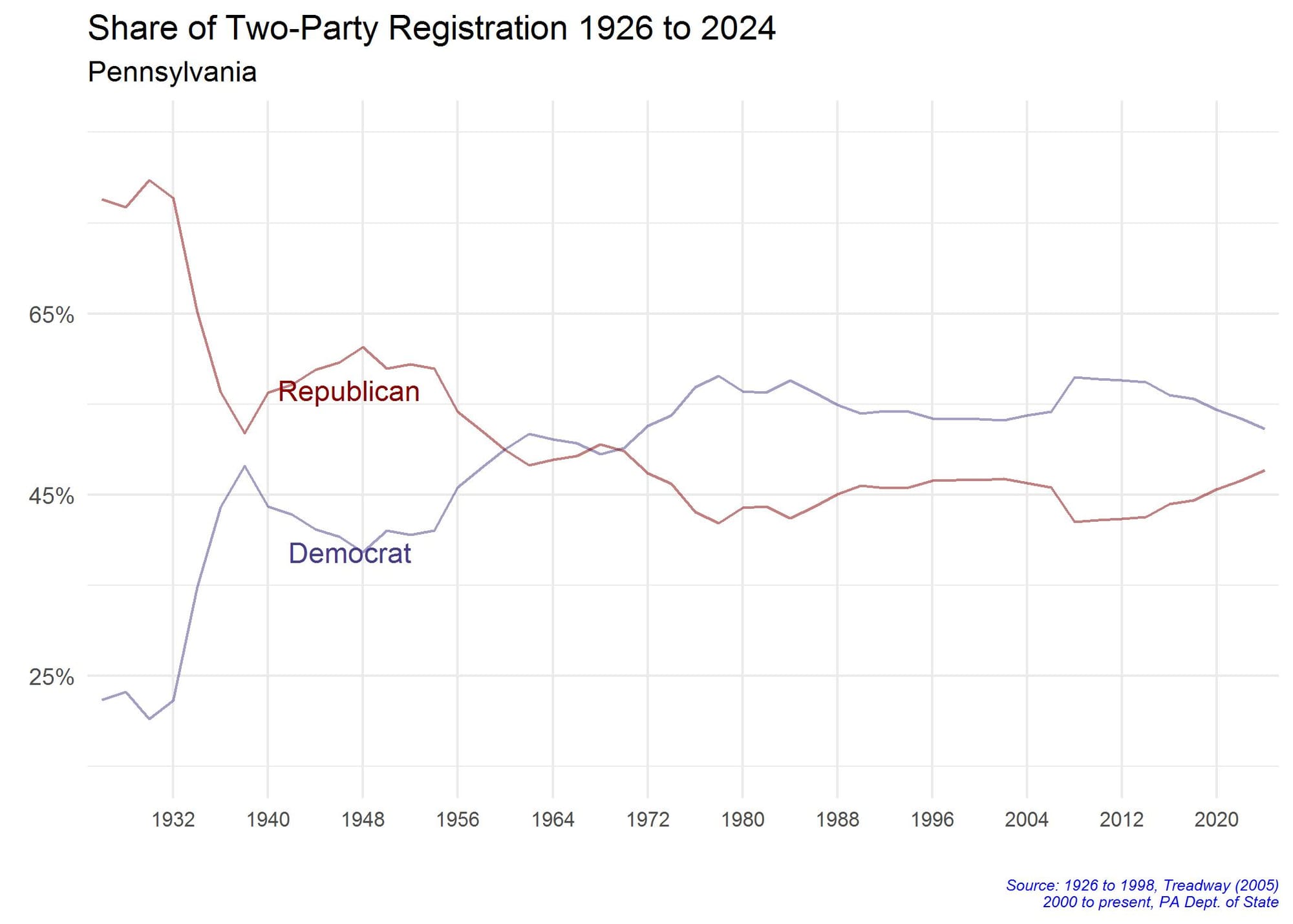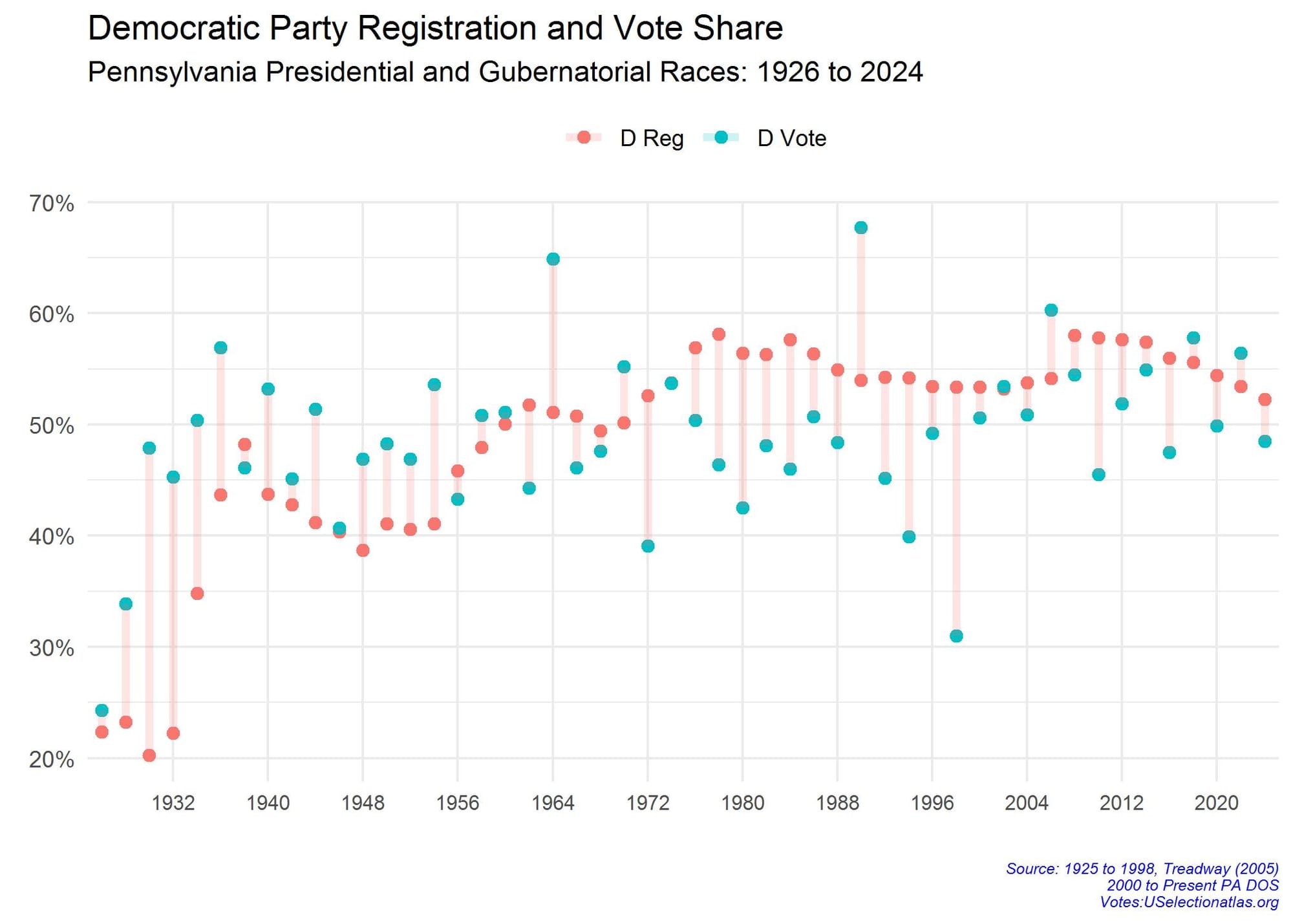Did Trump Reverse the Voter Registration Tide or Ride It?
Pennsylvania's partisan voter registration has tightened over the last decade. But did Trump really drive the changes? And do they represent a durable realignment that advantages Republicans?
Has President Trump Changed Pennsylvania’s Electorate?
More than one political analyst has been reflecting on trends in Pennsylvania’s voter registration rolls in light of the success that statewide Republican candidates had in 2024. For example, the main point of this assessment is that candidate Trump has whittled away the Democrat’s voter registration advantage in the state. Trump accomplished this by first, in 2016, making appeals to residents of the rural and southwestern parts of the state who seemed to be heading toward Republicans, then, in 2024, by bringing in new voters, particularly non-voters residing in urban communities.
In short, the story goes, Trump has changed the electorate in ways that favor Republicans, with some analysts hinting that Pennsylvania is headed the way of Florida, a one-time swing state that has become reliably Republican.
The state’s partisan voter registration has undoubtedly tightened over the last decade, and there have been geographic, demographic and social changes happening within each party. But did Trump really drive those changes? And do they represent a durable realignment in the state that advantages Republicans, making them the state’s dominant party?
Party Registration Since 2000: Partisan Change and Presidential Administrations
Aligning changes in voter registration to a president’s term of office is the most logical way to understand the effects presidential personalities and policies have on state politics. The single largest period of partisan change this century took place during the second term of the Bush administration, when Democratic registration surged and Republican registration sank (see Table 1). Voters in the second term of the Bush administration were extraordinarily negative about Bush’s performance and it notably changed the state’s partisan balance, giving Democrats a registration advantage of 1.2 million voters by the end of his term.
Table 1. Percent Change in Party Registration by Presidential Administration, Pennsylvania 2000 - 2024

The single largest drop in Democratic partisan registration took place during Biden’s term of office, which again corresponds to a period of relatively poor presidential ratings, even among Biden’s own partisans. The greatest increase in Republican registration this century happened during Trump’s first term, reflecting his popularity among Republicans. Still, the largest relative partisan growth during Trump’s first term was among third-party registrants.
In fact, growth in third-party registration outpaced growth for the major parties during every administration except during Bush’s second term. While both major parties had registration growth since 2000, third-parties had the most relative growth, rising from less than 800,000 voters in 2000 to 1.4 million in 2024.
A Long-term Perspective on Party Registration
From a historical perspective, the Trump bump is more a bend than a bounce (Figure 1). The registration shares seem to converge a bit faster after 2016, but there is no pronounced jump in registration as has appeared at other periods in the state’s history. The most abrupt change in the state’s voter registration happened between 1932 and 1936, during Franklin Roosevelt’s first term. From the civil war until the early 1950s, the state was dominated by the Republican Party organization. Republican dominance was so pronounced that in 1930 the Democratic candidate for governor withdrew from the race to become the Grand Exulted Ruler of the Elks Club. Pennsylvania was in fact one of only five states that voted for Herbert Hoover over Franklin Roosevelt in 1932. Roosevelt’s candidacy and presidency profoundly changed the state’s politics, finally making it possible for Democrats to compete in the state.

Other presidential eras have also produced noticeable breaks with past trends. The most pronounced changes took place in 1956 – 1960, 1972 – 1976, and 2004 – 2008, but none has come close to driving change like FDR’s New Deal. It is no coincidence that the sharpest swings in voter registration have coincided with sizable recessions.[i] The partisan movements associated with the Trump era fall closer to the normal rates of change evident throughout recent history than to the largest disruptions of past eras, perhaps because Trump had no objectively obvious economic tailwinds to ride. Many people reported being worse off economically in 2024 than in the prior year, but objective measures of GDP did not show a recession.
Party Registration and Partisan Electoral Success
Democrats gained a voter registration advantage in Pennsylvania around 1960, and they have not relinquished it since. But, voters’ pre-New Deal affinity for Republicans held in Pennsylvania for many years as voters more often than not preferred Republican candidates for major office over Democrats, despite their registration advantage. There is in fact evidence that although Democrats had a registration advantage in the state, there was a sizable chunk of registered Democrats who identified as Republicans and gave the party an operational advantage in state elections. From 1960 to 1999, despite Democrats having a clear registration advantage, Republicans won two-thirds (22/34 = 65%) of the state’s top tier races for president, senate, and governor. Throughout this period they also controlled the state senate and more often than not, the state house.
But things started to change in Pennsylvania after 2000, marking Donald Trump’s victory in 2016 as an exception to broader trends. From 2000 - 2022, 70% (14 of 20) of top tier races were won by Democrats. Democrats carried 5 of 6 gubernatorial races, 5 of 6 presidential races, and 4 of 8 senate races. Voting behaviors in the state clearly moved toward Democrats in the first part of this century, until 2024 when the Republicans swept the top tier races for president and US Senate.
Historically, the party with a voter registration advantage in the state typically under-performs (Figure 2). In the era before 1960, when Republicans had a decided voter registration advantage, the vote shares for Democratic gubernatorial and presidential candidates almost always exceeded their share of the registration. Since 1960, that pattern is reversed, with Democratic candidates almost always under-performing their registration. What is most remarkable and germane about the parties’ changing electoral fortunes is that gubernatorial and presidential vote shares are weakly correlated to voter registration (r=.37).

A close review of election returns shows that between 1960 and 2000 Democrats were able to get about 60% of their voters to show up for gubernatorial elections, while Republicans mobilized 75% of their registrants.[ii] That pattern has held into this century. This implies that the Democrats narrower partisan edge and traditionally lower voter mobilization will result in closer, more competitive races. This partisan differential in mobilization was obvious in 2024.
More of the Same, For Now
Identifying critical elections that signal a break from past politics is hard to do in real time. Sometimes a critical election produces a sudden notable change that fades gradually, as happened during the New Deal Era. In other circumstances, the initial changes are small but ripple outward and grow over time. Some say this happened in the mid-to late 1960s and played out into the emergence in the 1990s of sustainable Republican US House majorities. The evidence from history suggests that the Trump era, while significant for many reasons, has not been outside the norms of historical partisan switching. History also suggests the electoral ripple effects could play out for some time.
The changes in registration taking place during the Trump era were mostly created by his taking advantage of the changes already happening within the state’s electorate, including movement away from both major parties. The Trump-driven move in registrations does not yet give Republicans a durable advantage: the electoral implications of the state’s partisan shifts point to a near future that remains highly competitive because of a smaller registration advantage for Democrats and a rising share of third-party voters.
Then again, there is always the potential that what happens now from a policy standpoint could resonate with voters for years. Democrats had the opportunity in 2008 to create changes to the policy status quo that could have cemented their partisan advantages, but seemingly failed. Will Republicans be more successful at creating a new policy coalition from an electorate longing for change?
[i] The National Bureau of Economic Research identifies the seven largest declines in gross domestic product in the US by magnitude of GDP loss as happening in 1929–1933 (-26.7%); February and March 2020 (-19.2%); 1937-1938 (-10.2%), 1945 (-12.7%); 2007–2009 (-5.1%); 1958 (-3.7%); and 1973-1975 (-3.2%).
[ii] See the discussion of the Turnout-Loyalty Index in Jack Treadway, Elections in Pennsylvania (University Park, PA: The Pennsylvania State University Press, 2005), 35 – 38.
Franklin & Marshall College Poll Newsletter
Join the newsletter to receive the latest updates in your inbox.
